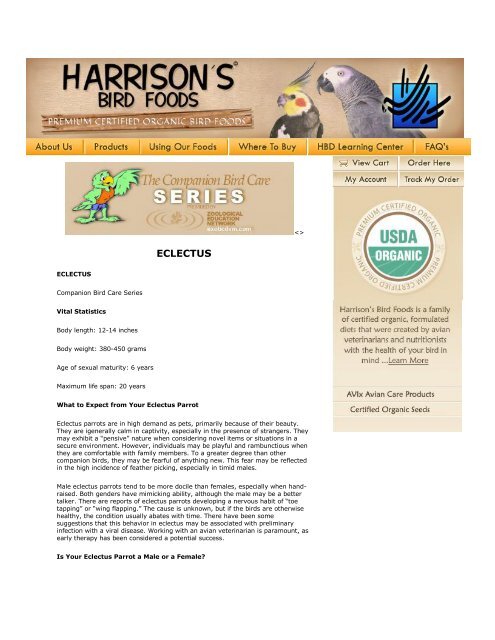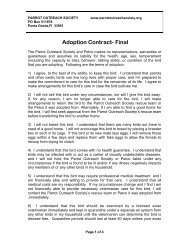ECLECTUS - Parrot Outreach Society
ECLECTUS - Parrot Outreach Society
ECLECTUS - Parrot Outreach Society
You also want an ePaper? Increase the reach of your titles
YUMPU automatically turns print PDFs into web optimized ePapers that Google loves.
<strong>ECLECTUS</strong><br />
<strong>ECLECTUS</strong><br />
Companion Bird Care Series<br />
Vital Statistics<br />
Body length: 12-14 inches<br />
Body weight: 380-450 grams<br />
Age of sexual maturity: 6 years<br />
Maximum life span: 20 years<br />
What to Expect from Your Eclectus <strong>Parrot</strong><br />
Eclectus parrots are in high demand as pets, primarily because of their beauty.<br />
They are igenerally calm in captivity, especially in the presence of strangers. They<br />
may exhibit a “pensive” nature when considering novel items or situations in a<br />
secure environment. However, individuals may be playful and rambunctious when<br />
they are comfortable with family members. To a greater degree than other<br />
companion birds, they may be fearful of anything new. This fear may be reflected<br />
in the high incidence of feather picking, especially in timid males.<br />
Male eclectus parrots tend to be more docile than females, especially when handraised.<br />
Both genders have mimicking ability, although the male may be a better<br />
talker. There are reports of eclectus parrots developing a nervous habit of “toe<br />
tapping” or “wing flapping.” The cause is unknown, but if the birds are otherwise<br />
healthy, the condition usually abates with time. There have been some<br />
suggestions that this behavior in eclectus may be associated with preliminary<br />
infection with a viral disease. Working with an avian veterinarian is paramount, as<br />
early therapy has been considered a potential success.<br />
Is Your Eclectus <strong>Parrot</strong> a Male or a Female?
It is easy to determine the gender of an eclectus parrot, not only because of<br />
behavioral characteristics, but because the male is bright green and the female is<br />
red. Because of the distinct color difference, eclectus parrots were originally<br />
believed to be two separate species. They are prolific breeders and the offspring<br />
are easy to hand-raise.<br />
What Do Eclectus <strong>Parrot</strong>s Do All Day?<br />
Toys offered to eclectus parrots must be free of toxic metals, hooks, sharp objects<br />
or small, easily consumed components. Fresh-cut branches from nontoxic trees<br />
may be offered. Check with local authorities for recommendations of safe trees.<br />
Eclectus need to feel they are a part of the group. They are nosy and interested in<br />
what is going on around them.<br />
Are Eclectus <strong>Parrot</strong>s Tame?<br />
Young, hand-raised eclectus parrots adapt readily to new surroundings and<br />
handling procedures. They should be exposed early in life to novel situations (car<br />
travel, hospital visits, multiple visitors in the household, other household pets) so<br />
that they are well adjusted to these events. Discipline, leadership, patience,<br />
hooding (covering the head), a sense of ritual and the offering of rewards are<br />
necessary to modify the behavior. Even then, they are not completely trustworthy<br />
with strangers and may bite for no apparent reason (especially the female).<br />
Why the Wings Should be Clipped<br />
Eclectus parrots that are allowed unrestricted freedom in the home can encounter<br />
numerous physical dangers or toxins; therefore, wing clipping is recommended.<br />
The goal of clipping the wings is NOT to make the bird incapable of flight, but to<br />
prevent it from developing rapid and sustained flight and to prevent escape. An<br />
eclectus will require additional trimming 8-12 weeks after the start of a molt cycle.<br />
How to Keep Your Eclectus <strong>Parrot</strong> Healthy, Happy and Safe!<br />
<br />
<br />
<br />
<br />
<br />
<br />
<br />
<br />
Give lots of attention.<br />
Feed a fresh, high quality, toxin-free formulated diet.<br />
Limit supplementation to small amounts of chopped vegetables or fruit<br />
per day.<br />
Grit is not necessary with modern captive bird diets.<br />
Provide clean, fresh, uncontaminated water.<br />
Remove and replace food and water containers twice daily to maximize<br />
activity in a healthy bird.<br />
Provide an occasional opportunity for bath, shower, or misting (at least<br />
weekly).*<br />
Avoid spraying house with insecticides.<br />
Housing for your eclectus parrot should:<br />
<br />
<br />
<br />
<br />
<br />
<br />
<br />
be as large as possible<br />
be clean, secure, safe and easy to service<br />
be constructed of durable, nontoxic material<br />
contain variable-sized perches made of clean, nontoxic pesticide-free<br />
tree branches<br />
have food and water containers placed at opposite ends of the enclosure<br />
avoid having perches located directly over food containers<br />
offer occasional opportunity for protected outdoor exposure to fresh air,<br />
sunlight and exercise
It is important to prevent eclectus parrots from access to:<br />
<br />
<br />
<br />
<br />
<br />
<br />
<br />
<br />
<br />
<br />
<br />
<br />
<br />
<br />
<br />
ceiling fans<br />
hot cooking oil<br />
overheated nonstick-coated cookware<br />
leg chains<br />
sandpaper-covered perches<br />
tobacco and cigarette smoke<br />
chocolate, avocado, salt, alcohol<br />
toxic houseplants<br />
pesticides<br />
toxic fumes<br />
easily dismantled toys<br />
dogs, cats and young children<br />
cedar, redwood and pressure-treated wood shavings<br />
sources of lead or zinc<br />
plug-in air fresheners<br />
*www.avi-x.com<br />
What Your Veterinarian Looks for in a Healthy Eclectus <strong>Parrot</strong><br />
<br />
<br />
<br />
<br />
<br />
<br />
<br />
Body free of lumps and bumps<br />
Smooth beak<br />
Alert, erect posture<br />
Smooth, bright feathers without color breaks, transparency or ragged<br />
edges<br />
Even, reptilian pattern on the feet, and nails of appropriate length<br />
Clear, bright black-colored eyes (no discharge)<br />
Dry, open nares<br />
Eclectus parrots originate from Australia, New Guinea and other South Pacific<br />
islands.<br />
Of the ten Eclectus subspecies, the three most commonly seen in captivity are the<br />
red-sided (Eclectus roratus polychloros), Vos (Eclectus roratus vosmaeri) and<br />
Solomon Island (Eclectus roratus solononesis).<br />
Eclectus have the most pronounced sexual dimorphism of any psittacine: the<br />
males are green and the females are red. Scientists who have studied these birds<br />
in Australia have determined that this color distinction is related to their sexual<br />
roles in the wild. Females spend up to 11 months each season in their nest hollow,<br />
and their red color makes them less conspicuous against the tree trunk. However,<br />
males differ from females by spending a much larger proportion of their time<br />
foraging among the rainforest canopy. Their green color favors reduced visibility to<br />
predators against leaves.<br />
In captivity, eclectus females generally tend to be more aggressive than males,<br />
both in companion bird settings and in aviculture. In breeding situations, a female<br />
may sometimes even traumatize her mate.<br />
Most Common Disorders of Eclectus <strong>Parrot</strong>s<br />
<br />
Feathering picking
Hypovitaminosis A<br />
Proventricular dilatation disease<br />
Chlamydiosis<br />
Bacterial infections<br />
Annular toe deformities (neonates)<br />
Female aggression, male docility<br />
Wing flapping and toe tapping<br />
Many common disease conditions in eclectus parrots are often the result of<br />
nutritional disorders. Visiting your avian veterinarian for routine health checks will<br />
help prevent many diseases and support you in having a long, satisfying<br />
relationship with your eclectus parrot.<br />
Zoological Education Network provides educational materials about exotic<br />
companion animals.<br />
©2005 Zoological Education Network<br />
800-946-4782 561-641-6745<br />
www.exoticdvm.com




